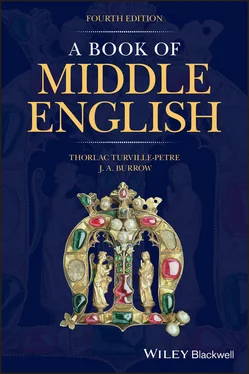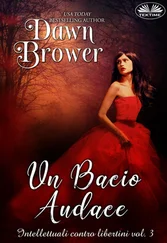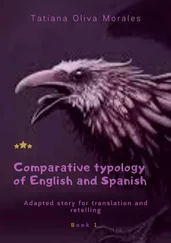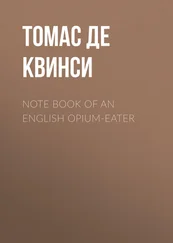Since Scandinavian languages were a branch of that same Germanic family to which English also belonged, many of the settlers’ words were similar in form and meaning to kindred (‘cognate’) native words. So in Middle English we find Scandinavian forms such as kyrk (Old Norse kirkja ) and gyfe (Old Norse gefa ) in more northerly texts (e.g. St Erkenwald , 11/16, 276), where southerly writers will use the equivalent native forms chirche (Old English cirice ) and yive (Old English giefan ).
3.3 English, French and Latin
Neither English literature nor the English language, as they developed in the years 1150–1400, can be understood without appreciating that there were in England throughout this period not one but three languages in active use: English, French and Latin. Latin was especially the second (or third) language of the scholar or ‘clerk’, who learned it in the Grammar course which formed the first part and foundation of the common medieval school syllabus (the Seven Liberal Arts). It was spoken – since women more rarely had the opportunity of learning Latin – mostly by men: monks preaching, diplomats negotiating, philosophers disputing. It was also the common written language of official documents, chronicles, the liturgy of the Church, theological treatises, and the like. Many native poets, too, wrote their verses in Latin. French and English were both in more general use. Norman French had been the first, maternal language of the Norman conquerors. For how long French continued to be the first language of the aristocracy and royalty of England is a matter of considerable dispute. King Henry IV (b. 1366) is said to have been the first post‐Conquest English monarch whose maternal language was English. Many other English people, especially among the gentry, spoke and wrote French; but for them it was generally a second, acquired language, more or less familiar but increasingly recognized as foreign. It remained, however, an acknowledged medium of administrative, legal and polite discourse, used and understood throughout the country – though not, usually, by the common people, whose sole language was most often English. This was the language which, according to one mid‐fourteenth‐century writer, everyone knew, learned and ignorant alike: ‘Boþe lered and lewed, olde and ʒonge, / Alle understonden English tonge’ ( Speculum Vitae ).
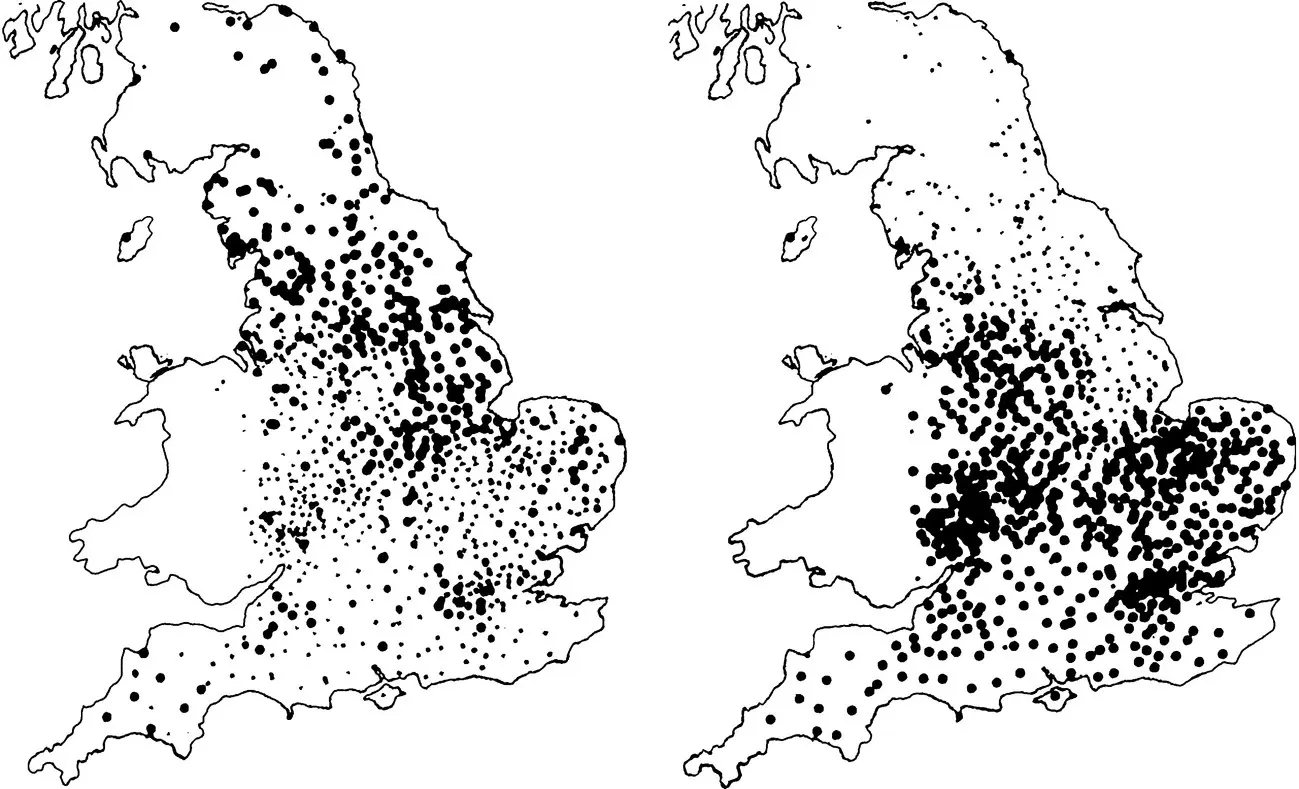
1 THEM: ‘th‐’ type, all variants.
2 THEM: ‘h‐’ type, all forms.
These two maps, reproduced with permission from A Linguistic Atlas of Late Mediaeval English (see Bibliography 9.2), show the distribution of words for ‘them’ beginning with ‘th‐’ (e.g. them , tham ) and ‘h‐’ (e.g. hem , ham ) respectively. The lighter dots mark the locality of the texts used as evidence by the Atlas . The heavy dots indicate the frequency of the forms in question in those texts where they occur: thus, the largest black dot indicates that the forms are either unrivalled or dominant there. These particular maps show that, in the period 1350–1450 covered by the Atlas , ‘h‐’ forms deriving from Old English were largely confined south of a line from the Mersey to the Wash, while the Northern ‘th‐’ forms, from Old Norse, were spreading south into that area: see 3.2 and 4.3.5.
Nowadays ‘literature‐in‐England’ forms only a small part of ‘literature‐in‐English’; but in the period 1150–1400 the opposite was the case. Literature‐in‐English was only a part of literature‐in‐England. Three examples will illustrate this. The early thirteenth‐century Ancrene Wisse (text 4 here) was written first in English for a community of anchoresses in Herefordshire; but it was soon translated into French and into Latin for the benefit of other readers – perhaps more noble in the one case and more learned in the other – who had devoted themselves to the religious life. Laʒamon’s Brut (also early thirteenth‐century, text 3 here) is an English version of a French poem by the Jersey poet Wace, who wrote, or so Laʒamon reports, for Eleanor of Aquitaine, wife of the English king Henry II. Wace’s Brut , in turn, is a version of a Latin chronicle of the kings of Britain written by another subject of the English crown, Geoffrey of Monmouth, in the 1130s. John Gower’s Confessio Amantis , written in the late fourteenth century (text 13 here), is, for all its Latin title, a poem in English; but Gower also wrote a long poem in Latin, the Vox Clamantis , and another in French, the Mirour de l’Omme – though this last effectively marked the end of Anglo‐Norman literature.
Given the co‐existence of these three languages, it is natural that words and idioms should have been carried over from one to another by bilingual users. Thus, French borrowed learned terms from Latin, and Latin drew on both French and English for various contemporary terms of technology, law, and the like. But English was the chief ‘borrower’, partly because it was for long the language of least prestige, and partly because, as it came to share and eventually take over the functions of French and later of Latin, it took over their vocabulary for the purpose.
Old English had already borrowed words from Latin, and in Middle English direct borrowing from Latin continued, but still on a fairly modest scale. Even such an evidently clerical work as St Erkenwald (text 11 here) has only four clear cases of post‐Conquest Latin borrowing: the administrative terms commit (201) and deputate (227), and the ecclesiastical martilage (‘martyrology’, 154) and pontificals (130). In the whole of the more popular romance Sir Orfeo (text 5) there are none at all. Direct borrowing from the Latin becomes more extensive in the work of fourteenth‐century translators of learned Latin treatises, such as John Trevisa (text 12 here); but these translators mark only the beginnings of the long process by which English was to supersede Latin as the language of learning and adopt much of its specialized terminology accordingly.
Like all Romance languages, French derives from the spoken language of the Roman Empire; but medieval French also borrowed direct, in both England and France, from the Latin known to and used by the scholars of the time. Thus, the medieval French word processioun did not come down in the vernacular from Roman antiquity: it was borrowed from the medieval Latin processio ( nem ). The Middle English processioun (5/587 here) reflects the form of the French word; but it is difficult – and unnecessary, so far as stylistic values are concerned – to distinguish between Latin and French sources in such a case. Perhaps it would be better to say that ‐ion and ‐ation words and many other similar are ‘Latin‐French’.
But French influence upon Middle English vocabulary was by no means confined to such rather bookish‐sounding Latinate words. Consider the opening lines of Sir Gawain and the Green Knight :
Siþen þe sege and þe assaut watz sesed at Troye,
þe borʒ brittened and brent to brondez and askez …
All the words in the second line are of Germanic (Old English or Scandinavian) origin; but the first line turns on three French words alliterating together. Sese (‘cease’, Old French cesser , Latin cessare ) is an example of a French word expressing a common idea with, in English, a certain extra politesse. Sege and assaut both belong to the language of post‐Conquest warfare: a castle (French castel ) is first besieged and then assaulted. Yet there is no strong sense of stylistic contrast between the two lines: taken together, they illustrate rather the intimate blending of the two languages. It has been calculated that, of a total of 2,650 words in this particular poem, as many as 750 are of French origin.
Читать дальше
